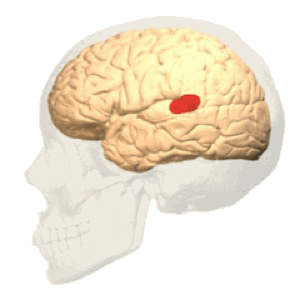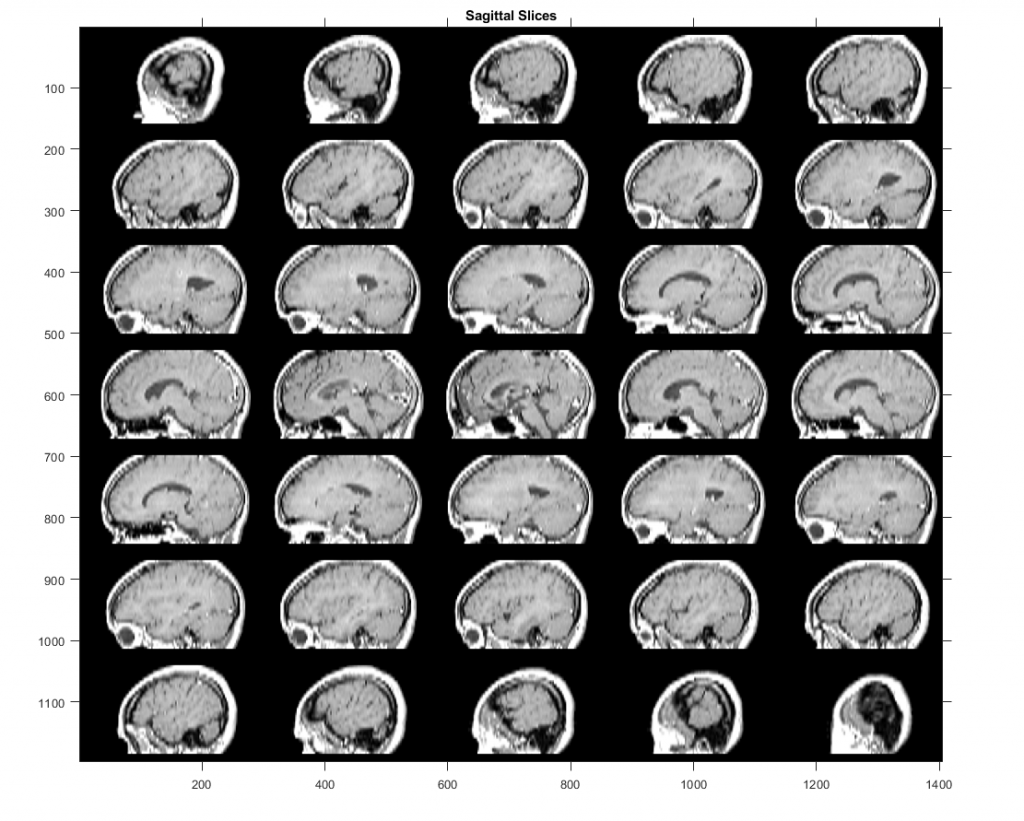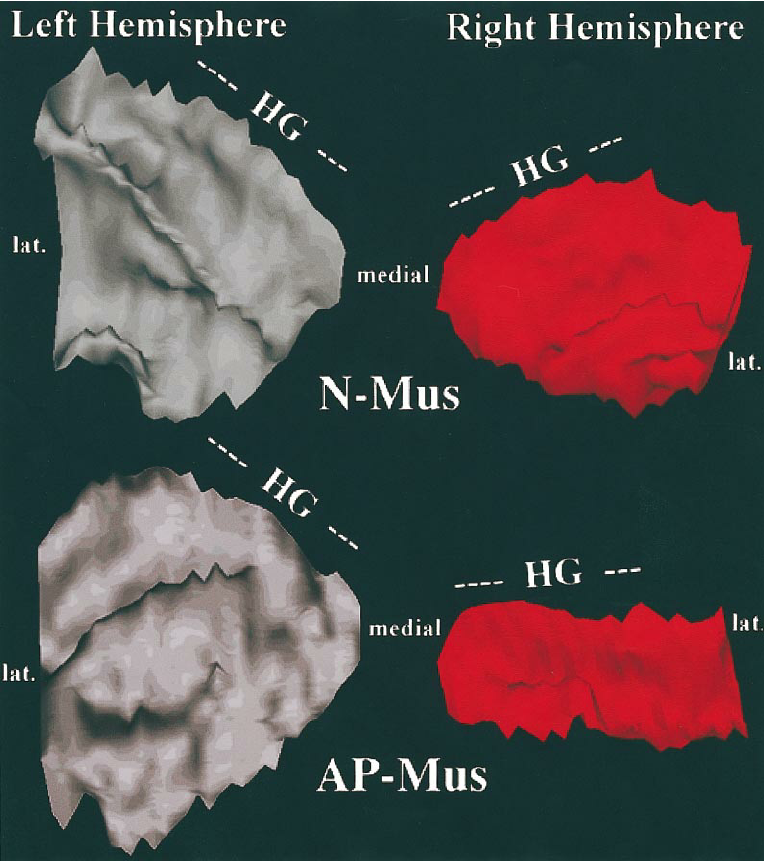Title of paper under discussion
Absolute Pitch and Planum Temporale
Authors
Julian Paul Keenan, Ven Thangaraj, Andrea R. Halpern and Gottfried Schlaug
Journal
NeuroImage, 14(6):1402-8, January 2002
Link to original paper (open access)
Overview
The planum temporale (PT), a triangular area just behind the primary auditory cortex on each of the two temporal lobes , is one of the most asymmetric regions of the brain, up to ten times bigger in the left than in the right hemisphere. This leftward asymmetry is more pronounced in males and in right-handers – and especially in musicians with perfect (absolute) pitch.

Taking place in Boston, Massachusetts in 2001, this study set out to investigate 1) whether the increased leftward asymmetry seen in musicians with absolute pitch (AP) was due to a larger than normal left PT or a smaller then normal right PT and 2) whether early exposure to music influenced the development of this asymmetry.
To this end, three groups were given brain scans to measure the sizes of their right and left PTs: “musicians with absolute pitch (AP)”, “musicians without AP” and “non-musicians”. (Both groups of musicians, those with and those without AP, had received early exposure to music training). As we will see, the “musicians with AP” had a near-normal sized left PT but a smaller than average right PT, suggesting that their PT leftward asymmetry is due to “pruning” of the right PT rather than expansion of the left PT. Meanwhile the brains of the “musicians without AP”, who had received a similar amount of early training as their AP colleagues, showed no such “pruning”, suggesting that although the development of AP may still depend on early musical training its associated leftward PT asymmetry has already been genetically determined.
Method
Three groups of right-handed participants – 27 musicians with AP, 22 musicians without AP and 22 non-musicians – had their brains scanned using magnetic resonance imaging. Brain scans are taken ‘slice by slice’ and expert neuroanatomists were asked to look at the series of slice scans of each participant, recognise the extent of the brain area in question – the planum temporale – and so measure its area (on both sides of the brain).

Results
The planum temporale leftward asymmetry value was similar in “non-musicians” and “musicians without Absolute Pitch”, but significantly greater in “musicians with Absolute Pitch”.
This was found to be due to a smaller-sized right (rather than a larger-sized left) planum temporale in “musicians with AP”.
The figure immediately below shows a comparison between the left planum temporale (grey) and right planum temporale (red) in a “non-musician” (top) and in a “musician with Absolute Pitch” (bottom) – note the much bigger asymmetry in the “musician with Absolute Pitch”:

Furthermore, a correlation analysis established that the size of the PT asymmetry did not depend on the age at which the musician had begun musical training.
Discussion
Although exposure to early musical training has been shown in many previous studies to be an important factor in the development of AP, this study – which included a comparison between two groups of musicians with similar exposure to early training (one group with AP and one without AP) and a group of non-musicians without any such early training – found that “this exposure in itself was not a determinant of an exaggerated leftward asymmetry”. Put another way, the authors conclude that “this finding suggests that in addition to the early commencement of musical training, the increased leftward asymmetry is a determinant for the manifestation of AP”.
A further way in which this study advanced our understanding of the brains of musicians with Absolute Pitch was in the nature of the exaggerated PT leftward asymmetry, namely that it was down to a smaller right, not a larger left, PT. the authors suggest that this may be due to “a pruning of the right PT early in development” though acknowledge this needs further research.
To conclude in the words of the authors:
“In summary, it was found that there was a greater leftward asymmetry in the PT of AP musicians compared to non-AP musicians and nonmusicians. The asymmetry appeared to be the result of a smaller right hemisphere PT rather than an increase in the left PT or a distribution of the two. These data suggest that early developmental pruning in the right PT may create an anatomical dominance of the left PT. This in turn might create a functional dominance of the left PT over the right PT, which might be necessary for the acquisition and/or manifestation of absolute pitch. This anatomical difference is likely due to factors other than early musical training or music exposure and it might indicate that young children with an increased leftward PT asymmetry might develop AP if they have an early music exposure.”
Coda
Arnold Schoenberg – Pierrot Lunaire
Jane Manning with Nash Ensemble (cond. – Simon Rattle)
Really interesting. Loving this site, Adrian..
Thanks Roger!
Fascinating as a musician with AP with a musician sister with AP.
In which case you’ll enjoy this! – https://www.ncbi.nlm.nih.gov/pmc/articles/PMC2706961/
Fascinating Adrian! I’ve forward details of your site to a friend of mine – violinist turned neuroscientist who is a professor at Birkbeck and has done some studies you would be very interested in. I think he’s going to ember in touch.
Thanks Ali, much appreciated! Adrian
I am a musician who started instrumental lessons aged 5. I was aware that I did not have AP. However, as the years went on I was gradually able to recognise the 4 violin string pitches and then the ‘white’ note keys and eventually all the keys. I had AP probably by the age of 13. People had always said to me that you were either born with it or not. I went on to have a music career in performance and teaching.
Now… To update. In the last few years due to illness and having children I have played less and less. My AP is now poor. It seems to be flat! When I think of an A, for example, it will often turn out to be a G#. The other factor that may have affected my brain is having had Electro Convulsive Therapy in 2017. I would be interested to know if it is the lack of musical engagement or the brain interference from the ECT that has affected me. I wonder if I were to get back to more playing whether my AP would become reliable again. Any thoughts, anyone?!
Thanks so much for comment and question Amy – I’m just the host but there’s an AP expert at Uni of Cambridge been getting in touch, I’ll put the question to him and report back. For what it’s worth, several people on Facebook have been reporting a flattening of pitch as we get older – you are not alone! Adrian
This from Miranda Fulleylove on FB: “To add to this confusing subject – as someone who plays baroque, classical and contemporary music at various pitches – there is such a thing as variable absolute pitch, when you recognise all pitches within the pitch system in which you happen to be playing at the time e.g A =440, A =435, A=415 or anything above A=440 as well, as in Germany, Austria or other parts of Europe. And also in Middle Eastern and Arabic music there are presumably many people with absolute pitch relating to those tonal systems too. All this suggests to me that absolute pitch is simply a particular kind of auditory memory – which is perhaps caused by (or related to) the temporal plane relationship between the two orbs of the brain as discussed in this study?”
And this from Sam Leak: “Hi Adrian – seems we’re both musicians studying AP – nice to meet you! Yeah the Schlaug studies are very interesting 🙂 Have you seen the Ken’ichi Miyazaki EEG stuff on the ‘Absolute Pitch Negativity’ distributed over the scalp near the left planum temporale? And Simon Leipold’s replication study where he was unable to find it? And also Leipold’s finding of an increased BOLD signal among AP musicians (compared to RP musicians) in the right planum temporale during pitch labelling tasks (which he thought might reflect the matching of pitch information with internal templates)?
I think the anatomical difference with regard to PT is one of the most interesting findings of the neuroscientific investigations into AP. I don’t think it’s damning to the idea of AP as learnable, given that brains are so plastic (there are cases of stroke victims regaining function while the responsible areas of their brain are dead). People should also realise that the areas of the brain we’re talking about are essentially implicated in auditory stuff, and language stuff – it’s easy to read this stuff and presume this is the ‘location’ of AP in the brain! Also AP seems to cover a range of skills and abilities, so the dichotomous ‘have it or you don’t’ idea doesn’t fit with the available evidence.
If you’re interested. Here’s an online talk I gave recently about all of this (in which I discuss the PT stuff 🙂 ): https://www.facebook.com/sam.leak2/videos/10158945533687150/
(and the reason I’m mentioning learnability is just that that’s the focus of my PhD!)
One thing that does concern me about this paper, and actually about a lot of the AP literature, is the poor operationalisation of, and testing for, AP. The initial Schlaug finding was based upon self-report of AP (so it wasn’t tested for), and the Schlaug and Keenan findings are based upon a single notes randomised sine tone test which is a) very atomistic, and not very ecologically valid (absolute pitch is far more than the ability to recognise acontextual single tones); and b) didn’t control for relative pitch use
It’s not just a failing of this paper. The fact that absolute pitch is yet to be given an adequate operational definition, or to have a suitable test designed for it, is one of the big failings of the literature. I think David Ross writes very well about this issue. One thing that I’ve noticed is that there tends to be a spread of AP abilities throughout the population, but with a massive cluster of top-scorers being seen as ‘Absolute Pitch Encoders’ or ‘True possessors’… could this not just be the result of a ceiling effect? Perhaps the tests are so unfit for purpose that the real differences between these top scorers aren’t being observed…
This from Richard Harwood on Twitter: “Any differences for left-handers wth absolute pitch, Adrian?” Over to you Sam?!
I have always been ‘tone deaf’ a great sadness for me. I know my brain is wired differently and I have compensatory gifts. But my auditory memory is very weak and at the age of 71 not likely to improve. Or can It?
Hi Christina, maybe take comfort from the most famous ‘tone deaf’ person in history – Charles Darwin. He loved music, but couldn’t remember or recognise even the most famous tunes – his friends at Cambridge would tease him by playing ‘God save the King’ and asking him to name it – he couldn’t. But he married Emma, a brilliant pianist, pupil of Chopin, and music was central to his family life. And he wrote more sense about the meaning of music than anyone in my opinion. By the way, I have literally no sense of direction and am always getting lost – but I enjoy some of the resultant journeys! Thanks for getting in touch, hope you keep enjoying the articles, Adrian
I grew up with AP, then got very confused with the early music movement – I still remember the first time I heard Hallelujah Chorus ‘in’ C sharp major when I switched on the radio, I thought it was some bizarre experiment. I trained myself to listen to A415 by forcing myself to ‘hear’ the names of the notes as I listened, rather than the pitch my brain was telling me to hear. (Does that make sense?) Over the years it all got soggy, and now I have no AP at all, until I know what a certain note is (eg, I will hear an open A string or something) and then the whole piece slips happily into its key for me.
Hi Stephen, thank you for commenting, note-naming is a fascinating solution to beholding baroque pitch with modern AP ears! I heard of a case last week where a woman’s AP has dropped a semitone and she now can’t bear to watch a pianist at work, so no longer goes to concerts – instead she has to listen on the radio. I was never blessed with AP (except being able to guess an ‘A’ if I imagine walking up to unlock my cello case) so can’t picture it going soggy, but it doesn’t sound too distressing!
Amusingly, following this thread, a 10 year old student of mine came yesterday and said he had heard a Youtube recording of Bach Italian Concerto on the harpsichord in E major! I didn’t direct him to this site, but I did tell him things would inevitably work out in the end!